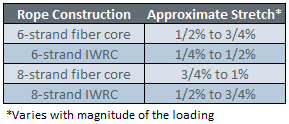Guide to Wire Rope
MENU
- Structural Wire Rope Applications
- Computer-Assisted Design and Detailing
- High Strength Structural Strand
- Custom Finishes
- Pre-stretching
- Striping
- Measuring Wire Rope
- Corrosion Protection
- End Terminations
- Attaching Sockets
- Proof loading
- Order Specifications
- Wire Rope Selection
- Rotation-Resistant Ropes
- Specialized Wire Rope
- Wire Rope Handling and Installation
- Standard Operating Practices
- Wire Rope Inspection
- Technical Info & Specifications
Physical Properties of Wire Rope
Constructional & Elastic Stretch
The following discussion relates to conventional 6- or 8-strand ropes that have either a fiber or steel core. It is not applicable to rotation-resistant ropes since these constitute a separate case.
Wire rope is an elastic member; it stretches and elongates under load. This stretch is derived from two sources:
Constructional stretch. When a load is applied to wire rope, the helically-laid wires and strands act in a restricting manner, thereby compressing the core and bringing all of the rope elements into closer contact. The result is a slight reduction in diameter and an accompanying lengthening of the rope. Constructional stretch is influenced by:
- Type of core
- Rope construction
- Length of lay
- Material
Ropes with a WSC or IWRC have less constructional stretch than those with a fiber core. The reason for this is steel cannot compress as much as the fiber core. Usually, constructional stretch will increase at an early stage in the rope's life. However, some fiber core ropes, if lightly loaded (as in the case of elevator ropes), may display a degree of constructional stretch over a considerable portion of their lives. A definite value for determining constructional stretch cannot be assigned since it is influenced by several factors. The Constructional Stretch table below gives some idea of the approximate stretch as a percentage of rope under load.
Constructional Stretch

Elastic Stretch

Elastic stretch. Elastic stretch results from recoverable deformation of the metal itself. Here again, a quantity cannot be precisely calculated. However, the equation shown above can provide a reasonable approximation for many situations.
In actuality, there may be a third source of stretch—a result of the rope's rotating on its own axis. Such elongation, which may occur either as a result of using a swivel, or from the effect of a free turning load, is brought about by the unlaying of rope strands. This type of stretch is undesirable and may lead to rope failure.

